Applications of Nanozymes in Chiral-Molecule Recognition through Electrochemical and Ultraviolet–Visible Analysis
Abstract
:1. Introduction
2. Synthesis of Chiral Nanozymes
3. UV–Vis Spectroscopy

4. Electrochemical Analysis
5. Discussion and Prospects
6. Conclusions
Author Contributions
Funding
Institutional Review Board Statement
Informed Consent Statement
Data Availability Statement
Conflicts of Interest
References
- Prelog, V. Chirality in Chemistry. Science 1976, 193, 17–24. [Google Scholar] [CrossRef] [PubMed]
- Zhang, M.; Qing, G.; Sun, T. Chiral Biointerface Materials. Chem. Soc. Rev. 2012, 41, 1972–1984. [Google Scholar] [CrossRef]
- Tan, X.; Zhang, Y.; Mao, H.; Yang, J. Recognition of Chiral Propranolol by Fluorescent Aptamerlight Switch Based on GO. Spectrochim. Acta Part A Mol. Biomol. Spectrosc. 2024, 305, 123436. [Google Scholar] [CrossRef]
- Wimmelbücker, L.; Kar, A. A History of Thalidomide in India. Med. Hist. 2023, 67, 228–246. [Google Scholar] [CrossRef]
- Bielská, L.; Hale, S.E.; Škulcová, L. A Review on the Stereospecific Fate and Effects of Chiral Conazole Fungicides. Sci. Total Environ. 2021, 750, 141600. [Google Scholar] [CrossRef]
- Vashistha, V.K. Detection and Remediation of Chiral Pharmaceuticals from Wastewater: A Review. Chirality 2022, 34, 833–847. [Google Scholar] [CrossRef]
- Gogolashvili, A.; Lomsadze, K.; Chankvetadze, L.; Takaishvili, N.; Peluso, P.; Dallocchio, R.; Salgado, A.; Chankvetadze, B. Separation of Tetrahydrozoline Enantiomers in Capillary Electrophoresis with Cyclodextrin-Type Chiral Selectors and Investigation of Chiral Recognition Mechanisms. J. Chromatogr. A 2021, 1643, 462084. [Google Scholar] [CrossRef] [PubMed]
- Betzenbichler, G.; Huber, L.; Kräh, S.; Morkos, M.K.; Siegle, A.F.; Trapp, O. Chiral Stationary Phases and Applications in Gas Chromatography. Chirality 2022, 34, 732–759. [Google Scholar] [CrossRef] [PubMed]
- Zhang, J.; Xie, S.; Yuan, L. Recent Progress in the Development of Chiral Stationary Phases for High-performance Liquid Chromatography. J. Sep. Sci. 2022, 45, 51–77. [Google Scholar] [CrossRef]
- Aroulanda, C.; Lesot, P. Molecular Enantiodiscrimination by NMR Spectroscopy in Chiral Oriented Systems: Concept, Tools, and Applications. Chirality 2022, 34, 182–244. [Google Scholar] [CrossRef]
- Sun, M.-X.; Ni, C.-Z.; Zhang, F.-Q.; Zhu, Y.-Y.; Zeng, J.; Gu, S.-X. Chiral Amino Acid Recognition in Water: A BINOL-Based Fluorescent Probe. Chin. Chem. Lett. 2023, 34, 108345. [Google Scholar] [CrossRef]
- Liu, Q.; Tang, S.; Wang, H.; Han, P. Stereospecific Recognition and Rapid Determination of d-Amino Acids in Human Serum Based on Luminescent Metal–Organic Frameworks. New J. Chem. 2022, 46, 8029–8036. [Google Scholar] [CrossRef]
- Chen, J.; Liu, X.; Zheng, G.; Feng, W.; Wang, P.; Gao, J.; Liu, J.; Wang, M.; Wang, Q. Detection of Glucose Based on Noble Metal Nanozymes: Mechanism, Activity Regulation, and Enantioselective Recognition. Small 2023, 19, 2205924. [Google Scholar] [CrossRef] [PubMed]
- Hao, J.; Li, Y.; Xu, X.; Zhao, F.; Pan, R.; Li, J.; Liu, H.; Wang, K.; Li, J.; Zhu, X.; et al. Metal-to-Ligand Charge Transfer Chirality Sensing of d-Glucose Assisted with GOX-Based Enzymatic Reaction. Adv. Mater. Technol. 2020, 5, 2000138. [Google Scholar] [CrossRef]
- Yi, Y.; Liu, L.; Wu, Y.; Zhu, G. Fluorescent and Colorimetric Dual-Signal Enantiomers Recognition via Enzyme Catalysis: The Case of Glucose Enantiomers Using Nitrogen-Doped Silicon Quantum Dots/Silver Probe Coupled with β-D-Glucose Oxidase. Anal. Sci. 2021, 37, 275–281. [Google Scholar] [CrossRef] [PubMed]
- Wu, J.; Wang, X.; Wang, Q.; Lou, Z.; Li, S.; Zhu, Y.; Qin, L.; Wei, H. Nanomaterials with Enzyme-like Characteristics (Nanozymes): Next-Generation Artificial Enzymes (II). Chem. Soc. Rev. 2019, 48, 1004–1076. [Google Scholar] [CrossRef] [PubMed]
- Wei, H.; Wang, E. Nanomaterials with Enzyme-like Characteristics (Nanozymes): Next-Generation Artificial Enzymes. Chem. Soc. Rev. 2013, 42, 6060. [Google Scholar] [CrossRef]
- Wang, Z.; Zhang, R.; Yan, X.; Fan, K. Structure and Activity of Nanozymes: Inspirations for de Novo Design of Nanozymes. Mater. Today 2020, 41, 81–119. [Google Scholar] [CrossRef]
- Huang, Y.; Ren, J.; Qu, X. Nanozymes: Classification, Catalytic Mechanisms, Activity Regulation, and Applications. Chem. Rev. 2019, 119, 4357–4412. [Google Scholar] [CrossRef] [PubMed]
- Zhang, R.; Yan, X.; Fan, K. Nanozymes Inspired by Natural Enzymes. Acc. Mater. Res. 2021, 2, 534–547. [Google Scholar] [CrossRef]
- Li, L.; Chen, R.; Jia, L. A Colorimetric Sensor for Chiral Recognition and Detection of Mandelic Acid Based on the Peroxidase-like Activity of Chiral Copper Oxide. Microchem. J. 2024, 200, 110187. [Google Scholar] [CrossRef]
- Zhu, J.-H.; Wang, H.; Guo, J.; Zhao, J.; Gao, Z.; Song, Y.-Y.; Zhao, C. Homochiral Light-Sensitive Metal-Organic Framework Photoelectrochemical Gated Transistor for Enantioselective Discrimination of Monosaccharides. Biosens. and Bioelectron. 2024, 258, 116336. [Google Scholar] [CrossRef] [PubMed]
- Zhou, Y.; Sun, H.; Xu, H.; Matysiak, S.; Ren, J.; Qu, X. Mesoporous Encapsulated Chiral Nanogold for Use in Enantioselective Reactions. Angew. Chem. Int. Ed. Engl. 2018, 57, 16791–16795. [Google Scholar] [CrossRef] [PubMed]
- Sun, Y.; Zhao, C.; Gao, N.; Ren, J.; Qu, X. Stereoselective Nanozyme Based on Ceria Nanoparticles Engineered with Amino Acids. Chem.—Eur. J. 2017, 23, 18146–18150. [Google Scholar] [CrossRef] [PubMed]
- Zhang, H.; He, H.; Jiang, X.; Xia, Z.; Wei, W. Preparation and Characterization of Chiral Transition-Metal Dichalcogenide Quantum Dots and Their Enantioselective Catalysis. ACS Appl. Mater. Interfaces 2018, 10, 30680–30688. [Google Scholar] [CrossRef] [PubMed]
- Zhang, M.; Zhang, W.; Fan, X.; Ma, Y.; Huang, H.; Wang, X.; Liu, Y.; Lin, H.; Li, Y.; Tian, H.; et al. Chiral Carbon Dots Derived from Serine with Well-Defined Structure and Enantioselective Catalytic Activity. Nano Lett. 2022, 22, 7203–7211. [Google Scholar] [CrossRef] [PubMed]
- Zhang, Y.; Zhang, M.; Ma, Y.; Du, X.; Li, W.; Hu, T.; Liu, Y.; Huang, H.; Kang, Z. Enhanced the Intrinsic Oxidase-like Activity of Chiral Carbon Dots via Manganese Doping for Selective Catalytic Oxidation. J. Colloid Interface Sci. 2024, 659, 687–696. [Google Scholar] [CrossRef] [PubMed]
- Lai, S.; Yang, D.; Wang, Y.; Ju, X.; Liu, W.; Li, H.; Wang, D.; Zhao, Y.; Wang, J.; Xu, H. Artificial Peroxidase of Short Peptide and Hemin Co-Assemblies with Selective Chiral Catalytic Activity in DOPA Oxidation. Colloids Surf. A Physicochem. Eng. Asp. 2023, 665, 131257. [Google Scholar] [CrossRef]
- Song, S.; Wang, J.; Song, N.; Di, H.; Liu, D.; Yu, Z. Peptide Interdigitation-Induced Twisted Nanoribbons as Chiral Scaffolds for Supramolecular Nanozymes. Nanoscale 2020, 12, 2422–2433. [Google Scholar] [CrossRef]
- Li, D.; Gao, C.; Zhao, C.; Sun, Q.; Xi, Z.; Han, J.; Guo, R. Phenylglycine Amphiphile-Metal Ion Chiral Supramolecular Nanozymes for Enantioselective Catalysis. Chem. Commun. 2024, 60, 4569–4572. [Google Scholar] [CrossRef]
- Zhang, R.; Zhou, Y.; Yan, X.; Fan, K. Advances in Chiral Nanozymes: A Review. Microchim Acta 2019, 186, 782. [Google Scholar] [CrossRef] [PubMed]
- Das, K.; Balaram, H.; Sanyal, K. Amino Acid Chirality: Stereospecific Conversion and Physiological Implications. ACS Omega 2024, 9, 5084–5099. [Google Scholar] [CrossRef] [PubMed]
- Wang, Y.; Lan, D.; Durrani, R.; Hollmann, F. Peroxygenases En Route to Becoming Dream Catalysts. What Are the Opportunities and Challenges? Curr. Opin. Chem. Biol. 2017, 37, 1–9. [Google Scholar] [CrossRef] [PubMed]
- Zhang, Y.; Cui, T.; Yang, J.; Huang, Y.; Ren, J.; Qu, X. Chirality-Dependent Reprogramming of Macrophages by Chiral Nanozymes. Angew. Chem. Int. Ed. Engl. 2023, 62, e202307076. [Google Scholar] [CrossRef] [PubMed]
- Gao, H.; Cui, D.; Kou, J.; Zhao, H.; Sun, C.; Wang, X.; Su, Z. Single Crystal X-Ray Structure Determination and Enantiomeric Recognition of Chiral Dinuclear Europium (III) Complexes towards BINOL. Inorg. Chem. Commun. 2021, 134, 109025. [Google Scholar] [CrossRef]
- Chen, J.L.-Y.; Pezzato, C.; Scrimin, P.; Prins, L.J. Chiral Nanozymes–Gold Nanoparticle-Based Transphosphorylation Catalysts Capable of Enantiomeric Discrimination. Chem. Eur. J. 2016, 22, 7028–7032. [Google Scholar] [CrossRef] [PubMed]
- Mukhina, M.V.; Maslov, V.G.; Baranov, A.V.; Fedorov, A.V.; Orlova, A.O.; Purcell-Milton, F.; Govan, J.; Gun’ko, Y.K. Intrinsic Chirality of CdSe/ZnS Quantum Dots and Quantum Rods. Nano Lett. 2015, 15, 2844–2851. [Google Scholar] [CrossRef] [PubMed]
- Luo, X.-M.; Gong, C.-H.; Pan, F.; Si, Y.; Yuan, J.-W.; Asad, M.; Dong, X.-Y.; Zang, S.-Q.; Mak, T.C.W. Small Symmetry-Breaking Triggering Large Chiroptical Responses of Ag70 Nanoclusters. Nat. Commun. 2022, 13, 1177. [Google Scholar] [CrossRef] [PubMed]
- Ruiyi, L.; Xiaobo, W.; Yuanfeng, P.; Pengwu, X.; Haiyan, Z.; Zaijun, L.; Xiulan, S. Synthesis of Gold Nanocrystals with Chiral Morphology, Chiral Ligand and More Exposed High-Index Facets as Electrocatalyst for the Oxidation of Glucose Enantiomers with High Enantioselectivity and Catalytic Activity. Catal. Sci. Technol. 2022, 12, 2097–2105. [Google Scholar] [CrossRef]
- Li, Q.; Wu, C.; Zhang, J.; Su, R.; Wang, Y.; Qi, W. Construction of Chiral Nanozymes with High Enantioselectivity for Visual Detection via Smartphone-Based Paper Sensors. Chem. Eng. J. 2024, 495, 153326. [Google Scholar] [CrossRef]
- Mendes, A.C.; Baran, E.T.; Reis, R.L.; Azevedo, H.S. Self-assembly in Nature: Using the Principles of Nature to Create Complex Nanobiomaterials. Wiley Interdiscip. Rev. Nanomed. Nanobiotechnol. 2013, 5, 582–612. [Google Scholar] [CrossRef] [PubMed]
- Liu, M.; Zhang, L.; Wang, T. Supramolecular Chirality in Self-Assembled Systems. Chem. Rev. 2015, 115, 7304–7397. [Google Scholar] [CrossRef] [PubMed]
- Wang, Z.-G.; Wang, H.; Liu, Q.; Duan, F.; Shi, X.; Ding, B. Designed Self-Assembly of Peptides with G-Quadruplex/Hemin DNAzyme into Nanofibrils Possessing Enzyme-Mimicking Active Sites and Catalytic Functions. ACS Catal. 2018, 8, 7016–7024. [Google Scholar] [CrossRef]
- Chen, G.-Y.; Chai, T.-Q.; Wang, J.-L.; Yang, F.-Q. Recent Advances in the Colorimetric and Fluorescence Analysis of Bioactive Small-Molecule Compounds Based on the Enzyme-like Activity of Nanomaterials. J. Pharm. Biomed. Anal. 2023, 236, 115695. [Google Scholar] [CrossRef] [PubMed]
- Xu, C.; Zhao, C.; Li, M.; Wu, L.; Ren, J.; Qu, X. Artificial Evolution of Graphene Oxide Chemzyme with Enantioselectivity and Near-Infrared Photothermal Effect for Cascade Biocatalysis Reactions. Small 2014, 10, 1841–1847. [Google Scholar] [CrossRef] [PubMed]
- Hu, S.; Shuai, Q.; Lin, Y.; Fu, Y.; Li, M. Chiral Fe x Cu y Se Nanoparticles as Peroxidase Mimics for Colorimetric Detection of 3, 4-Dihydroxy-Phenylalanine Enantiomers. Nanotechnology 2022, 33, 135503. [Google Scholar] [CrossRef] [PubMed]
- Zhou, Y.; Wei, Y.; Ren, J.; Qu, X. A Chiral Covalent Organic Framework (COF) Nanozyme with Ultrahigh Enzymatic Activity. Mater. Horiz. 2020, 7, 3291–3297. [Google Scholar] [CrossRef]
- Sha, M.; Rao, L.; Xu, W.; Qin, Y.; Su, R.; Wu, Y.; Fang, Q.; Wang, H.; Cui, X.; Zheng, L.; et al. Amino-Ligand-Coordinated Dicopper Active Sites Enable Catechol Oxidase-Like Activity for Chiral Recognition and Catalysis. Nano Lett. 2023, 23, 701–709. [Google Scholar] [CrossRef] [PubMed]
- Si, Q.; Wang, F.; Ding, Q.; Yang, W.; Lin, H.; Xu, C.; Li, S. Chiral CuxCoyS-CuzS Nanoflowers with Bioinspired Enantioselective Catalytic Performances. Small 2024, 20, 2311275. [Google Scholar] [CrossRef]
- Zhan, P.; Wang, Z.-G.; Li, N.; Ding, B. Engineering Gold Nanoparticles with DNA Ligands for Selective Catalytic Oxidation of Chiral Substrates. ACS Catal. 2015, 5, 1489–1498. [Google Scholar] [CrossRef]
- Xu, L.; Sun, M.; Cheng, P.; Gao, R.; Wang, H.; Ma, W.; Shi, X.; Xu, C.; Kuang, H. 2D Chiroptical Nanostructures for High-Performance Photooxidants. Adv. Funct. Mater. 2018, 28, 1707237. [Google Scholar] [CrossRef]
- Zhou, Y.; Wei, W.; Cui, F.; Yan, Z.; Sun, Y.; Ren, J.; Qu, X. Construction of a Chiral Artificial Enzyme Used for Enantioselective Catalysis in Live Cells. Chem. Sci. 2020, 11, 11344–11350. [Google Scholar] [CrossRef] [PubMed]
- Ma, Q.; Cheng, C.; Luo, D.; Qiao, J.; Qi, L. Dipeptide-Capped Copper Nanoparticles as Chiral Nanozymes for Colorimetric Enantioselective Recognition of 3,4-Dihydroxy-d, l-Phenylalanine. ACS. Appl. Bio. Mater. 2023, 6, 1676–1682. [Google Scholar] [CrossRef]
- Tian, L.; Cheng, C.; Zhao, Z.; Liu, W.; Qi, L. Colorimetric Recognition of 3,4-Dihydroxy-D,L-Phenylalanine with Tetrapeptide-Modified Copper Nanoparticles as Chiral Nanozymes. Chem. Res. Chin. Univ. 2023, 39, 1092–1099. [Google Scholar] [CrossRef]
- Wang, C.; Yuan, G.; Wang, C.; Sun, X.; Hang, P.; Xi, Z.; Han, J.; Guo, R. Supramolecular Chiral Nanozymes with High and Switchable Enantioselectivity. Small Struct. 2023, 4, 2200405. [Google Scholar] [CrossRef]
- Yuan, G.; Wang, C.; Xi, Z.; Li, S.; Sun, X.; Hang, P.; Liu, X.; Han, J.; Guo, R. Supramolecular Polyaniline-Metal Ion as Chiral Nanozymes for Enantioselective Catalysis. Small 2023, 19, 2303739. [Google Scholar] [CrossRef]
- Jiang, W.; He, R.; Lv, H.; He, X.; Wang, L.; Wei, Y. Chiral Sensing of Tryptophan Enantiomers Based on the Enzyme Mimics of β-Cyclodextrin-Modified Sulfur Quantum Dots. ACS Sens. 2023, 8, 4264–4271. [Google Scholar] [CrossRef] [PubMed]
- Chen, L.; Chen, Y.; Zhang, Y.; Liu, Y. Photo-Controllable Catalysis and Chiral Monosaccharide Recognition Induced by Cyclodextrin Derivatives. Angew. Chem. Int. Ed. Engl. 2021, 60, 7654–7658. [Google Scholar] [CrossRef]
- Ouyang, Y.; Biniuri, Y.; Fadeev, M.; Zhang, P.; Carmieli, R.; Vázquez-González, M.; Willner, I. Aptamer-Modified Cu2+-Functionalized C-Dots: Versatile Means to Improve Nanozyme Activities-“Aptananozymes”. J. Am. Chem. Soc. 2021, 143, 11510–11519. [Google Scholar] [CrossRef]
- Wu, Y.; Qin, Y.; Muppidathi, M.; Carmieli, R.; Fadeev, M.; Lei, W.; Xia, M.; Willner, I. Functional Nanozymes Consisting of Co2+-ZIF-67 Metal-Organic Framework Nanoparticles and Co2+-ZIF-67/Polyaniline Conjugates. Adv. Funct. Mater. 2024, 34, 2306929. [Google Scholar] [CrossRef]
- Zandieh, M.; Liu, J. Nanozymes: Definition, Activity, and Mechanisms. Adv. Mater. 2024, 36, 2211041. [Google Scholar] [CrossRef] [PubMed]
- Sun, Y.; Xu, B.; Pan, X.; Wang, H.; Wu, Q.; Li, S.; Jiang, B.; Liu, H. Carbon-Based Nanozymes: Design, Catalytic Mechanism, and Bioapplication. Coord. Chem. Rev. 2023, 475, 214896. [Google Scholar] [CrossRef]
- Song, Y.; Qu, K.; Zhao, C.; Ren, J.; Qu, X. Graphene Oxide: Intrinsic Peroxidase Catalytic Activity and Its Application to Glucose Detection. Adv. Mater. 2010, 22, 2206–2210. [Google Scholar] [CrossRef]
- Lu, Y.; Zhang, H.; Zhu, Y.; Marriott, P.J.; Wang, H. Emerging Homochiral Porous Materials for Enantiomer Separation. Adv. Funct. Mater. 2021, 31, 2101335. [Google Scholar] [CrossRef]
- Jin, J.; Li, L.; Zhang, L.; Luan, Z.; Xin, S.; Song, K. Progress in the Application of Carbon Dots-Based Nanozymes. Front. Chem. 2021, 9, 748044. [Google Scholar] [CrossRef] [PubMed]
- Zhang, M.; Ma, Y.; Wang, H.; Wang, B.; Zhou, Y.; Liu, Y.; Shao, M.; Huang, H.; Lu, F.; Kang, Z. Chiral Control of Carbon Dots via Surface Modification for Tuning the Enzymatic Activity of Glucose Oxidase. ACS Appl. Mater. Interfaces 2021, 13, 5877–5886. [Google Scholar] [CrossRef]
- Klabunde, T.; Eicken, C.; Sacchettini, J.C.; Krebs, B. Crystal Structure of a Plant Catechol Oxidase Containing a Dicopper Center. Nat. Struct. Mol. Biol. 1998, 5, 1084–1090. [Google Scholar] [CrossRef] [PubMed]
- Chen, X.-Y.; Ha, W.; Jin, X.-J.; Shi, Y.-P. PEGylated NALC-Functionalized Gold Nanoparticles for Colorimetric Discrimination of Chiral Tyrosine. Analyst 2020, 145, 7397–7405. [Google Scholar] [CrossRef] [PubMed]
- Chen, G.-Y.; Chai, T.-Q.; Zhang, H.; Yang, F.-Q. Applications of Mild-Condition Synthesized Metal Complexes with Enzyme-like Activity in the Colorimetric and Fluorescence Analysis. Coord. Chem. Rev. 2024, 508, 215761. [Google Scholar] [CrossRef]
- Shah, M.; Shah, J.; Arya, H.; Vyas, A.; Vijapura, A.; Gajipara, A.; Shamal, A.; Bakshi, M.; Thakore, P.; Shah, R.; et al. Biological Oxidase Enzyme Mimetic Cu-Pt Nanoalloys: A Multifunctional Nanozyme for Colorimetric Detection of Ascorbic Acid and Identification of Mammalian Cells. ChemistrySelect 2019, 4, 6537–6546. [Google Scholar] [CrossRef]
- Gilabert, M.Á.; Fenoll, L.G.; García-Molina, F.; García-Ruiz, P.A.; Tudela, J.; García-Cánovas, F.; Rodríguez-López, J.N. Stereospecificity of Horseradish Peroxidase. Biol. Chem. 2004, 385, 1177–1184. [Google Scholar] [CrossRef] [PubMed]
- Tang, Y.; Jiang, S.; Li, W.; Jalil Shah, S.; Zhao, Z.; Pan, L.; Zhao, Z. Confined Construction of COF@Cu-Nanozyme with High Activity and Stability as Laccase Biomimetic Catalyst for the Efficient Degradation of Phenolic Pollutants. Chem. Eng. J. 2022, 448, 137701. [Google Scholar] [CrossRef]
- Chai, H.; Yu, K.; Zhao, Y.; Zhang, Z.; Wang, S.; Huang, C.; Zhang, X.; Zhang, G. MOF-On-MOF Dual Enzyme-Mimic Nanozyme with Enhanced Cascade Catalysis for Colorimetric/Chemiluminescent Dual-Mode Aptasensing. Anal. Chem. 2023, 95, 10785–10794. [Google Scholar] [CrossRef] [PubMed]
- Wang, L.; Sun, Y.; Zhang, H.; Shi, W.; Huang, H.; Li, Y. Selective Sensing of Catechol Based on a Fluorescent Nanozyme with Catechol Oxidase Activity. Spectrochim. Acta A Mol. Biomol. Spectrosc. 2023, 302, 123003. [Google Scholar] [CrossRef] [PubMed]
- Wang, J.; Huang, R.; Qi, W.; Su, R.; He, Z. Preparation of Amorphous MOF Based Biomimetic Nanozyme with High Laccase- and Catecholase-like Activity for the Degradation and Detection of Phenolic Compounds. Chem. Eng. J. 2022, 434, 134677. [Google Scholar] [CrossRef]
- Blaschek, L.; Pesquet, E. Phenoloxidases in Plants—How Structural Diversity Enables Functional Specificity. Front. Plant Sci. 2021, 12, 754601. [Google Scholar] [CrossRef] [PubMed]
- Le, T.N.; Le, X.A.; Tran, T.D.; Lee, K.J.; Kim, M.I. Laccase-Mimicking Mn–Cu Hybrid Nanoflowers for Paper-Based Visual Detection of Phenolic Neurotransmitters and Rapid Degradation of Dyes. J. Nanobiotechnol. 2022, 20, 358. [Google Scholar] [CrossRef] [PubMed]
- Ortiz-Martínez, M.; González-González, M.; Martagón, A.J.; Hlavinka, V.; Willson, R.C.; Rito-Palomares, M. Recent Developments in Biomarkers for Diagnosis and Screening of Type 2 Diabetes Mellitus. Curr. Diab. Rep. 2022, 22, 95–115. [Google Scholar] [CrossRef] [PubMed]
- Stefan-van Staden, R.; Mitrofan, G. Molecular Enantiorecognition of l-glucose and d-glucose in Whole Blood Samples. Chirality 2018, 30, 680–685. [Google Scholar] [CrossRef]
- Anastasiou, I.A.; Eleftheriadou, I.; Tentolouris, A.; Mourouzis, I.; Pantos, C.; Tentolouris, N. The Use of L-Glucose in Cancer Diagnosis: Results from In Vitro and In Vivo Studies. CMC 2021, 28, 6110–6122. [Google Scholar] [CrossRef]
- Wang, N.; Zhao, L.; Liu, C.; Zhang, J.; He, Y.; Yang, H.; Liu, X. Chiral Detection of Glucose: An Amino Acid-Assisted Surface-Enhanced Raman Scattering Strategy Showing Opposite Enantiomeric Effects on SERS Signals. Anal. Chem. 2022, 94, 14565–14572. [Google Scholar] [CrossRef] [PubMed]
- Deshmukh, A.R.; Aloui, H.; Kim, B.S. Novel Biogenic Gold Nanoparticles Catalyzing Multienzyme Cascade Reaction: Glucose Oxidase and Peroxidase Mimicking Activity. Chem. Eng. J. 2021, 421, 127859. [Google Scholar] [CrossRef]
- Niu, X.; Zhao, R.; Liu, Y.; Yuan, M.; Zhao, H.; Li, H.; Yang, X.; Xu, H.; Wang, K. Adaptive Host–Guest Chiral Recognition in Nanoarchitectonics with Biomimetic MOF Mimicking DNA. J. Mater. Chem. A 2023, 11, 23376–23386. [Google Scholar] [CrossRef]
- Xu, G.; Du, X.; Wang, W.; Qu, Y.; Liu, X.; Zhao, M.; Li, W.; Li, Y. Plasmonic Nanozymes: Leveraging Localized Surface Plasmon Resonance to Boost the Enzyme-Mimicking Activity of Nanomaterials. Small 2022, 18, 2204131. [Google Scholar] [CrossRef] [PubMed]
- Cheng, P.; Wang, H.; Shi, X. The Effect of Phenylalanine Ligands on the Chiral-Selective Oxidation of Glucose on Au (111). Nanoscale 2020, 12, 3050–3057. [Google Scholar] [CrossRef]
- Wei, D.; Yu, Y.; Ge, L.; Wang, Z.; Chen, C.; Guo, R. Chiral Supramolecular Polymers Assembled by Amphiphilic Oligopeptide-Perylene Diimides and High Electrochemical Sensing. Langmuir 2021, 37, 9232–9243. [Google Scholar] [CrossRef] [PubMed]
- Desmarchelier, A.; Caumes, X.; Raynal, M.; Vidal-Ferran, A.; Van Leeuwen, P.W.N.M.; Bouteiller, L. Correlation between the Selectivity and the Structure of an Asymmetric Catalyst Built on a Chirally Amplified Supramolecular Helical Scaffold. J. Am. Chem. Soc. 2016, 138, 4908–4916. [Google Scholar] [CrossRef] [PubMed]
- He, S.; Shang, X.; Lu, W.; Tian, Y.; Xu, Z.; Zhang, W. Electrochemical Enantioselective Sensor for Effective Recognition of Tryptophan Isomers Based on Chiral Polyaniline Twisted Nanoribbon. Anal. Chim. Acta 2021, 1147, 155–164. [Google Scholar] [CrossRef]
- Wang, S.-Y.; Li, L.; Xiao, Y.; Wang, Y. Recent Advances in Cyclodextrins-Based Chiral-Recognizing Platforms. TrAC Trends Anal. Chem. 2019, 121, 115691. [Google Scholar] [CrossRef]
- Pu, C.; Xu, Y.; Liu, Q.; Zhu, A.; Shi, G. Enantiomers of Single Chirality Nanotube as Chiral Recognition Interface for Enhanced Electrochemical Chiral Analysis. Anal. Chem. 2019, 91, 3015–3020. [Google Scholar] [CrossRef]
- Zhang, W.; Chen, Y.; Yu, J.; Zhang, X.-J.; Liu, Y. Photo/Chemo Dual-Controlled Reversible Morphological Conversion and Chiral Modulation of Supramolecular Nanohelixes with Nanosquares and Nanofibers. Chem. Commun. 2016, 52, 14274–14277. [Google Scholar] [CrossRef] [PubMed]
- Zhong, Y.; Zhao, J.; Li, J.; Liao, X.; Chen, F. Advances of Aptamers Screened by Cell-SELEX in Selection Procedure, Cancer Diagnostics and Therapeutics. Anal. Biochem. 2020, 598, 113620. [Google Scholar] [CrossRef] [PubMed]
- Bu, Z.; Huang, L.; Li, S.; Tian, Q.; Tang, Z.; Diao, Q.; Chen, X.; Liu, J.; Niu, X. Introducing Molecular Imprinting onto Nanozymes: Toward Selective Catalytic Analysis. Anal. Bioanal. Chem. 2024; ahead of print. [Google Scholar] [CrossRef] [PubMed]
- Wu, W.; Li, J. Recent Progress on Nanozymes in Electrochemical Sensing. J. Electroanal. Chem. 2023, 936, 117391. [Google Scholar] [CrossRef]
- Upadhyay, S.S.; Kalambate, P.K.; Srivastava, A.K. Enantioselective Biomimetic Sensor for Discrimination of R and S-Clopidogrel Promoted by β-Cyclodextrin Complexes Employing Graphene and Platinum Nanoparticle Modified Carbon Paste Electrode. J. Electroanal. Chem. 2019, 840, 305–312. [Google Scholar] [CrossRef]
- Song, Y.; Lu, S.; Hai, J.; Liang, K.; Sun, S.; Meng, G.; Wang, B. Nitrogen-Doped Chiral CuO/CoO Nanofibers: An Enhanced Electrochemiluminescence Sensing Strategy for Detection of 3,4-Dihydroxy-Phenylalanine Enantiomers. Anal. Chem. 2021, 93, 11470–11478. [Google Scholar] [CrossRef] [PubMed]
- Liu, C.; Sun, L.; Yang, G.; Cheng, Q.; Wang, C.; Tao, Y.; Sun, X.; Wang, Z.; Zhang, Q. Chiral Au–Pd Alloy Nanorods with Tunable Optical Chirality and Catalytically Active Surfaces. Small 2023, 20, 2310353. [Google Scholar] [CrossRef] [PubMed]
- Dai, Z.; Guo, J.; Zhao, C.; Gao, Z.; Song, Y.-Y. Fabrication of Homochiral Metal–Organic Frameworks in TiO 2 Nanochannels for In Situ Identification of 3,4-Dihydroxyphenylalanine Enantiomers. Anal. Chem. 2021, 93, 11515–11524. [Google Scholar] [CrossRef] [PubMed]
- Xu, H.; Guo, J.; Zhao, J.; Gao, Z.; Song, Y.-Y. Target Recognition-Triggered Peroxidase-Mimicking Activity Depression in Homochiral Nanochannels for Identifying Cystine Enantiomers. Anal. Chem. 2023, 95, 5436–5442. [Google Scholar] [CrossRef]
- Dai, Z.; Guo, J.; Su, T.; Wang, J.; Gao, Z.; Song, Y.-Y. Nature-Inspired Mineralization of a Wood Membrane as a Sensitive Electrochemical Sensing Device for in Situ Recognition of Chiral Molecules. Green Chem. 2021, 23, 8685–8693. [Google Scholar] [CrossRef]
- Zhang, L.; Qiao, C.; Cai, X.; Xia, Z.; Han, J.; Yang, Q.; Zhou, C.; Chen, S.; Gao, S. Microcalorimetry-Guided Pore-Microenvironment Optimization to Improve Sensitivity of Ni-MOF Electrochemical Biosensor for Chiral Galantamine. Chem. Eng. J. 2021, 426, 130730. [Google Scholar] [CrossRef]
- Guo, J.; Liu, X.; Zhao, J.; Xu, H.; Gao, Z.; Wu, Z.-Q.; Song, Y.-Y. Rational Design of Mesoporous Chiral MOFs as Reactive Pockets in Nanochannels for Enzyme-Free Identification of Monosaccharide Enantiomers. Chem. Sci. 2023, 14, 1742–1751. [Google Scholar] [CrossRef] [PubMed]
- Xu, H.; Guo, J.; Zhao, J.; Gao, Z.; Song, Y.-Y. Enantioselective Target Transport-Mediated Nanozyme Decomposition for the Identification of Reducing Enantiomers in Asymmetric Nanochannel Arrays. Anal. Chem. 2023, 95, 14465–14474. [Google Scholar] [CrossRef] [PubMed]
- Ford, N.F. The Metabolism of Clopidogrel: CYP2C19 Is a Minor Pathway. J. Clin. Pharmacol. 2016, 56, 1474–1483. [Google Scholar] [CrossRef] [PubMed]
- Pereillo, J.-M.; Maftouh, M.; Andrieu, A.; Uzabiaga, M.-F.; Fedeli, O.; Savi, P.; Pascal, M.; Herbert, J.-M.; Maffrand, J.-P.; Picard, C. Structure and Stereochemistry of the Active Metabolite of Clopidogrel. Drug Metab. Dispos. 2002, 30, 1288–1295. [Google Scholar] [CrossRef] [PubMed]
- Reist, M.; Vos, M.R.; Montseny, J.-P.; Mayer, J.M.; Carrupt, P.-A.; Berger, Y.; Testa, B. Very Slow Chiral Inversion of Clopidogrel in Rats: A Pharmacokinetic and Mechanistic Investigation. Drug Metab. Dispos. 2000, 28, 1405–1410. [Google Scholar] [PubMed]
- VanEtten, R.L.; Sebastian, J.F.; Clowes, G.A.; Bender, M.L. Acceleration of Phenyl Ester Cleavage by Cycloamyloses. A Model for Enzymic Specificity. J. Am. Chem. Soc. 1967, 89, 3242–3253. [Google Scholar] [CrossRef]
- Salehnia, F.; Hosseini, M.; Ganjali, M.R. Enhanced Electrochemiluminescence of Luminol by an in Situ Silver Nanoparticle-Decorated Graphene Dot for Glucose Analysis. Anal. Methods 2018, 10, 508–514. [Google Scholar] [CrossRef]
- Wu, F.-X.; Li, F.-H.; Lv, X.-L.; Zhang, Q.-X.; Xu, G.-B.; Niu, W.-X. Heteroepitaxial Growth of Au@Pd Core–Shell Nanocrystals with Intrinsic Chiral Surfaces for Enantiomeric Recognition. Rare Met. 2024, 43, 225–235. [Google Scholar] [CrossRef]
- Guo, J.; Yang, L.; Gao, Z.; Zhao, C.; Mei, Y.; Song, Y.-Y. Insight of MOF Environment-Dependent Enzyme Activity via MOFs-in-Nanochannels Configuration. ACS Catal. 2020, 10, 5949–5958. [Google Scholar] [CrossRef]
- Zhou, S.; Guo, J.; Dai, Z.; Liu, C.; Zhao, J.; Gao, Z.; Song, Y.-Y. Engineering Homochiral MOFs in TiO2 Nanotubes as Enantioselective Photoelectrochemical Electrode for Chiral Recognition. Anal. Chem. 2021, 93, 12067–12074. [Google Scholar] [CrossRef] [PubMed]
- Zor, E.; Bingol, H.; Ramanaviciene, A.; Ramanavicius, A.; Ersoz, M. An Electrochemical and Computational Study for Discrimination of D- and L-Cystine by Reduced Graphene Oxide/β-Cyclodextrin. Analyst 2014, 140, 313–321. [Google Scholar] [CrossRef] [PubMed]
- Goldfarb, D.S.; Coe, F.L.; Asplin, J.R. Urinary Cystine Excretion and Capacity in Patients with Cystinuria. Kidney Int. 2006, 69, 1041–1047. [Google Scholar] [CrossRef] [PubMed]
- Xu, J.; Wang, M.; Li, M.; Yang, J.; Yang, L. Paper-Based Chiral Biosensors Using Enzyme Encapsulation in Hydrogel Network for Point-of-Care Detection of Lactate Enantiomers. Anal. Chim. Acta 2023, 1279, 341834. [Google Scholar] [CrossRef] [PubMed]
- Mu, R.; Wang, Z.; Wamsley, M.C.; Duke, C.N.; Lii, P.H.; Epley, S.E.; Todd, L.C.; Roberts, P.J. Application of Enzymes in Regioselective and Stereoselective Organic Reactions. Catalysts 2020, 10, 832. [Google Scholar] [CrossRef]
- Wang, F.; Chen, X.; Wang, Y.; Li, X.; Wan, M.; Zhang, G.; Leng, F.; Zhang, H. Insights into the Structures, Inhibitors, and Improvement Strategies of Glucose Oxidase. Int. J. Mol. Sci. 2022, 23, 9841. [Google Scholar] [CrossRef] [PubMed]
- Wang, J.; Bao, M.; Wei, T.; Wang, Z.; Dai, Z. Bimetallic Metal–Organic Framework for Enzyme Immobilization by Biomimetic Mineralization: Constructing a Mimic Enzyme and Simultaneously Immobilizing Natural Enzymes. Anal. Chim. Acta 2020, 1098, 148–154. [Google Scholar] [CrossRef] [PubMed]
- Wang, P.; Wang, S.; Zhang, W.; Li, X.; Gu, Z.; Li, W.; Zhao, S.; Fu, Y. Preparation of MOF Catalysts and Simultaneously Modulated Metal Nodes and Ligands via a One-Pot Method for Optimizing Cycloaddition Reactions. New J. Chem. 2020, 44, 9611–9615. [Google Scholar] [CrossRef]
- Zhao, L.; Kuang, X.; Kuang, R.; Tong, L.; Liu, Z.; Hou, Y.; Sun, X.; Wang, Z.; Wei, Q. MOF-Based Supramolecule Helical Nanomaterials: Toward Highly Enantioselective Electrochemical Recognition of Penicillamine. ACS Appl. Mater. Interfaces 2020, 12, 1533–1538. [Google Scholar] [CrossRef]
- Lan, L.; Song, X.; Kuang, X.; Sun, X.; Kuang, R. Chiral Discrimination of Penicillamine Enantiomers: The Role of Aggregation-Caused Quenching in Achieving High Selectivity. Anal. Chem. 2023, 95, 14659–14664. [Google Scholar] [CrossRef]
- Hu, M.; Feng, H.-T.; Yuan, Y.-X.; Zheng, Y.-S.; Tang, B.Z. Chiral AIEgens—Chiral Recognition, CPL Materials and Other Chiral Applications. Coord. Chem. Rev. 2020, 416, 213329. [Google Scholar] [CrossRef]
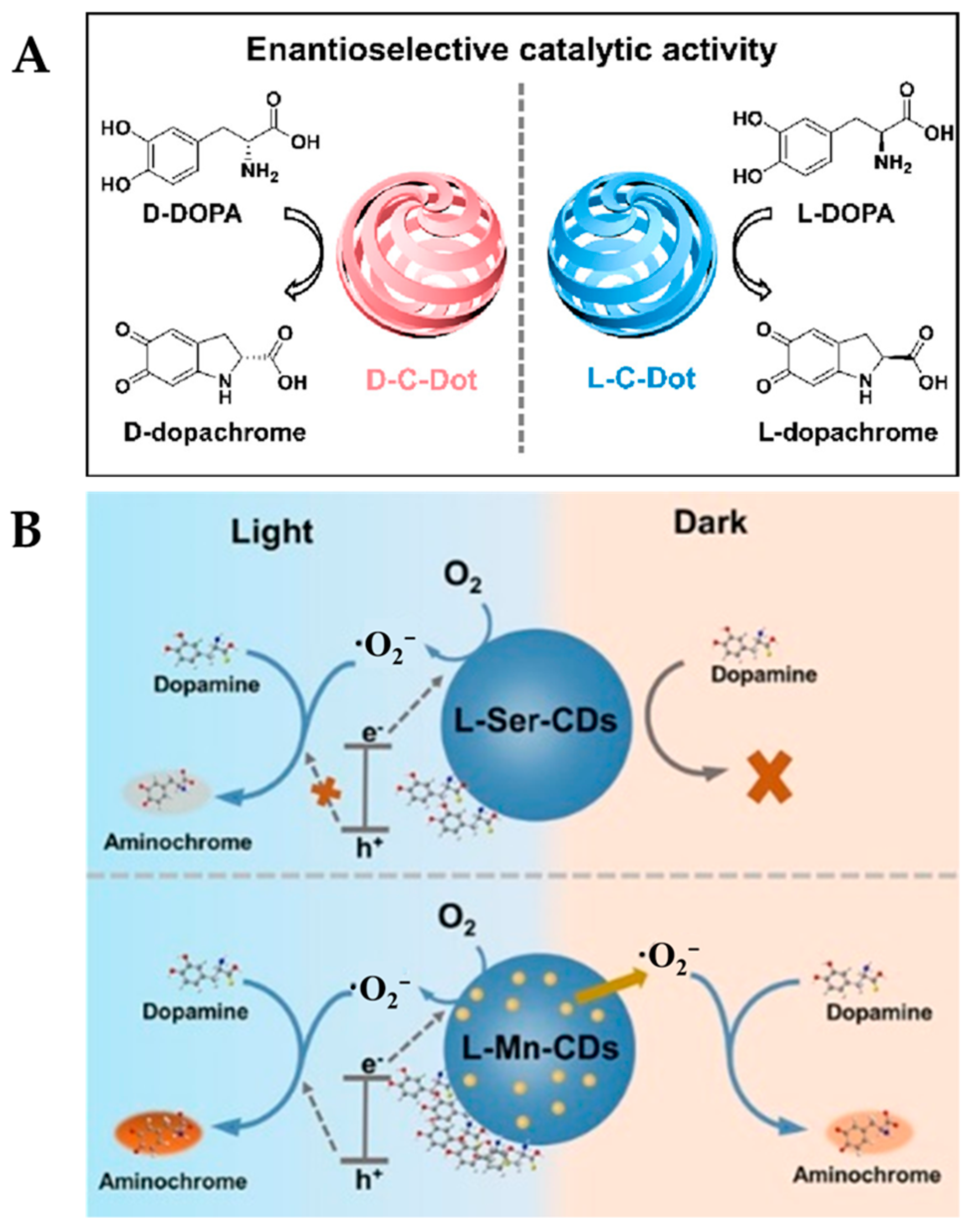
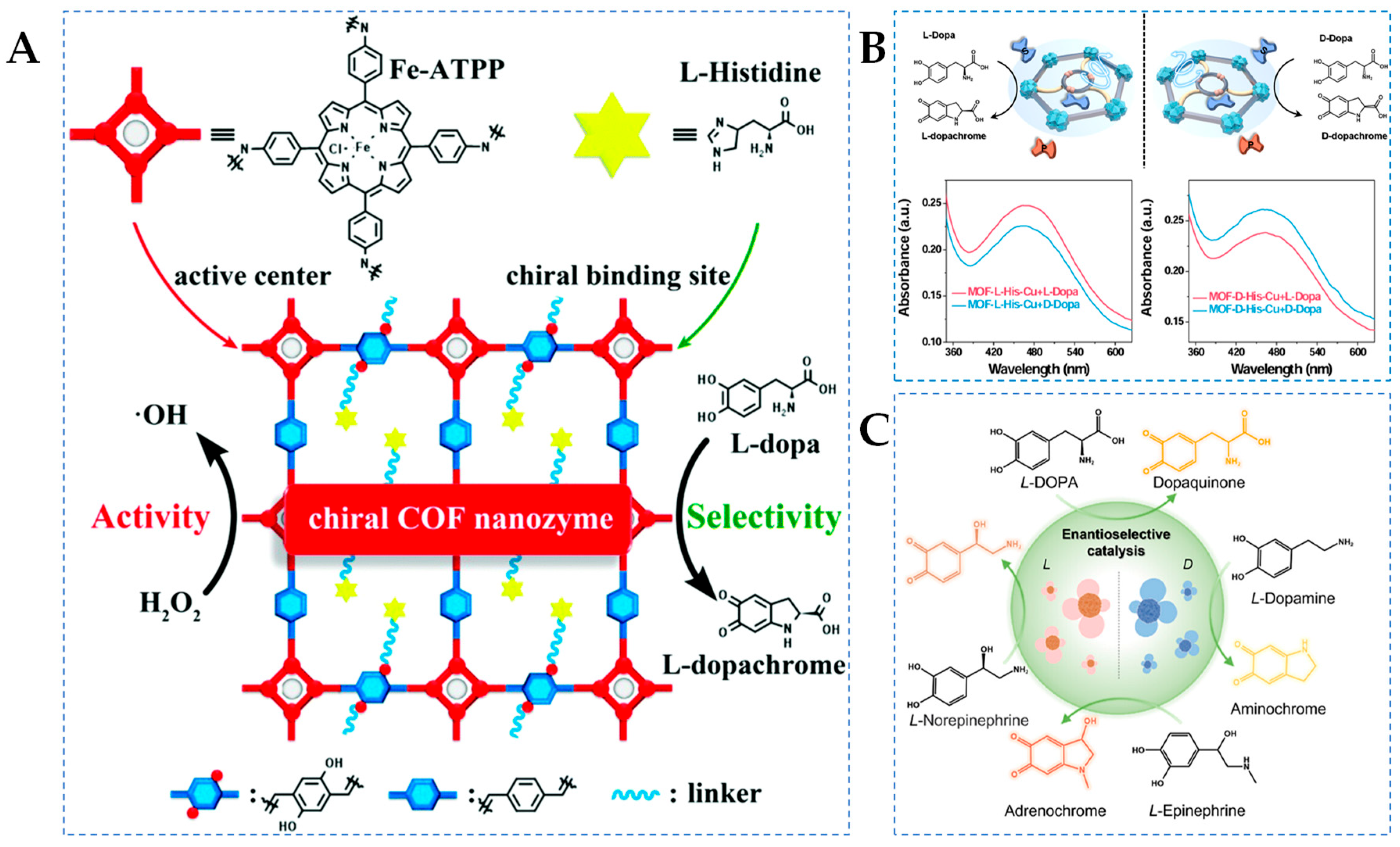
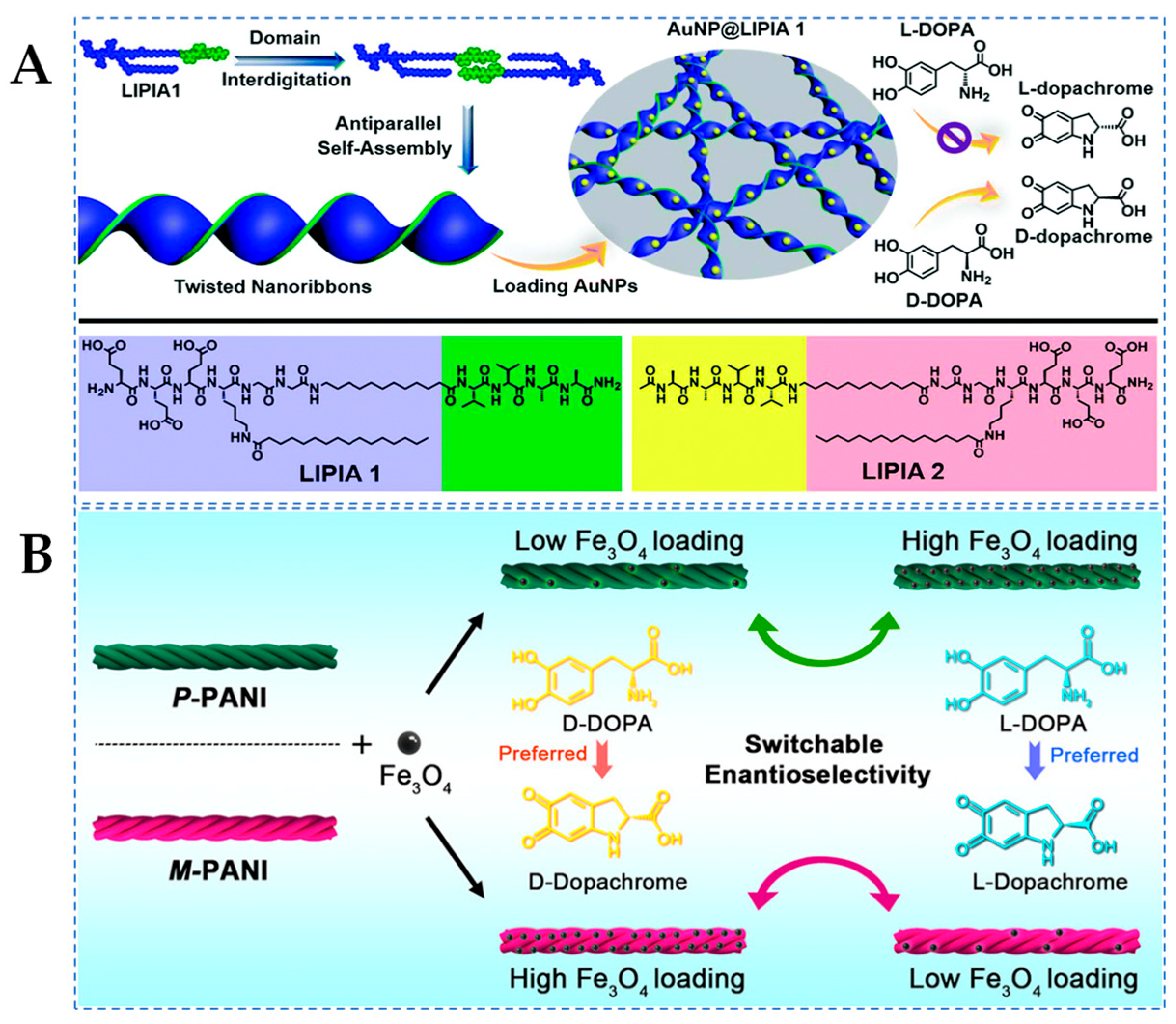

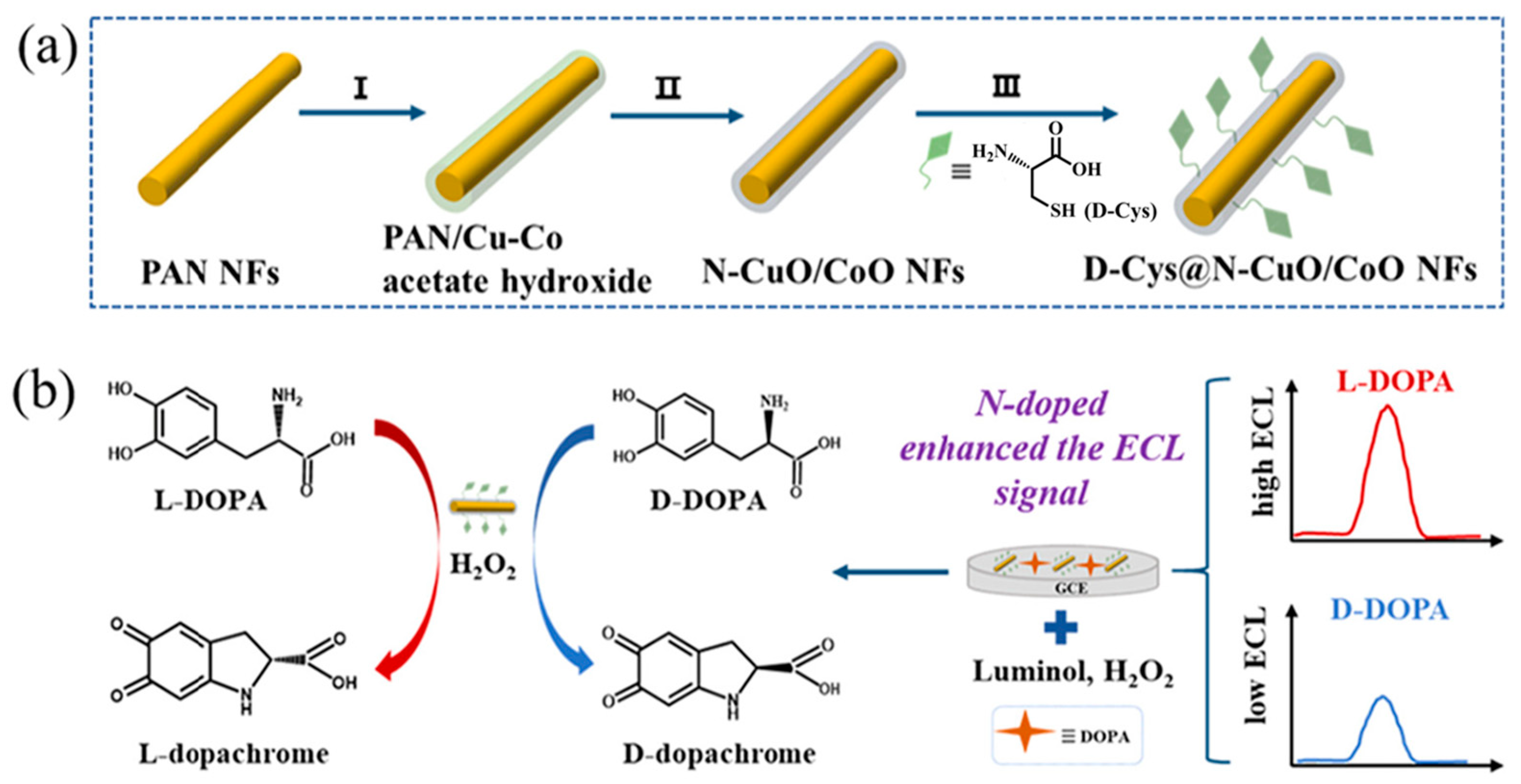
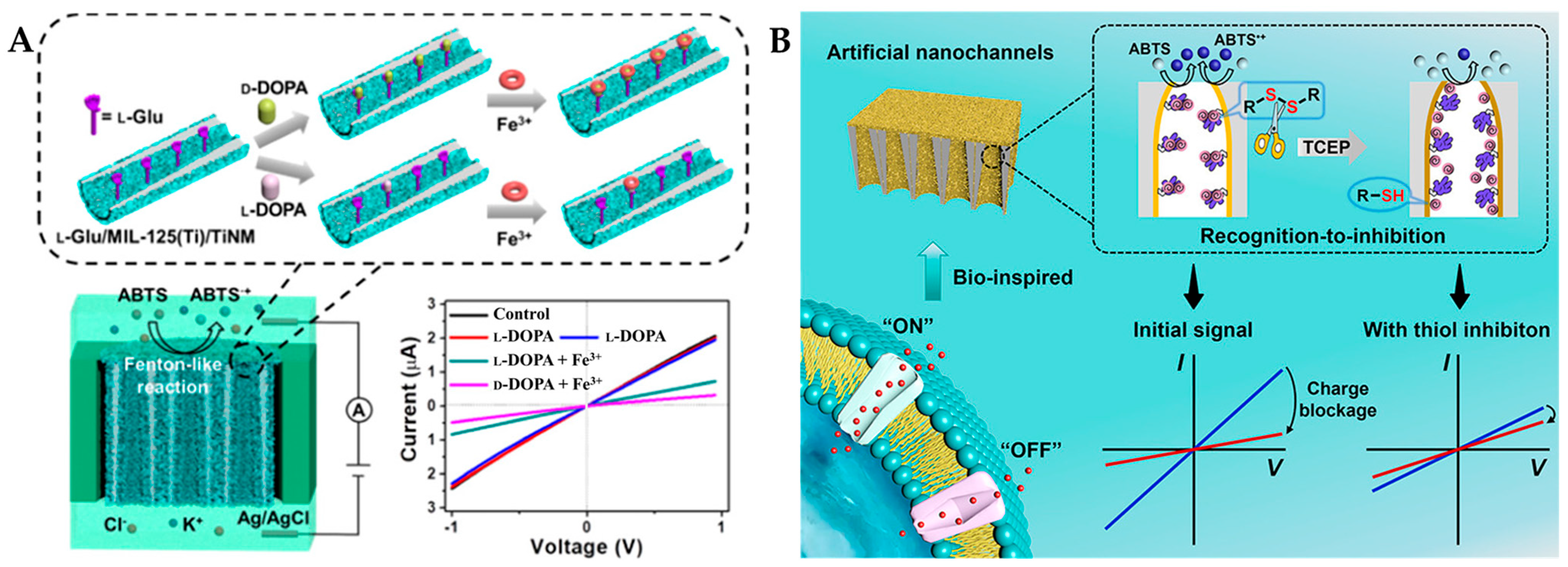
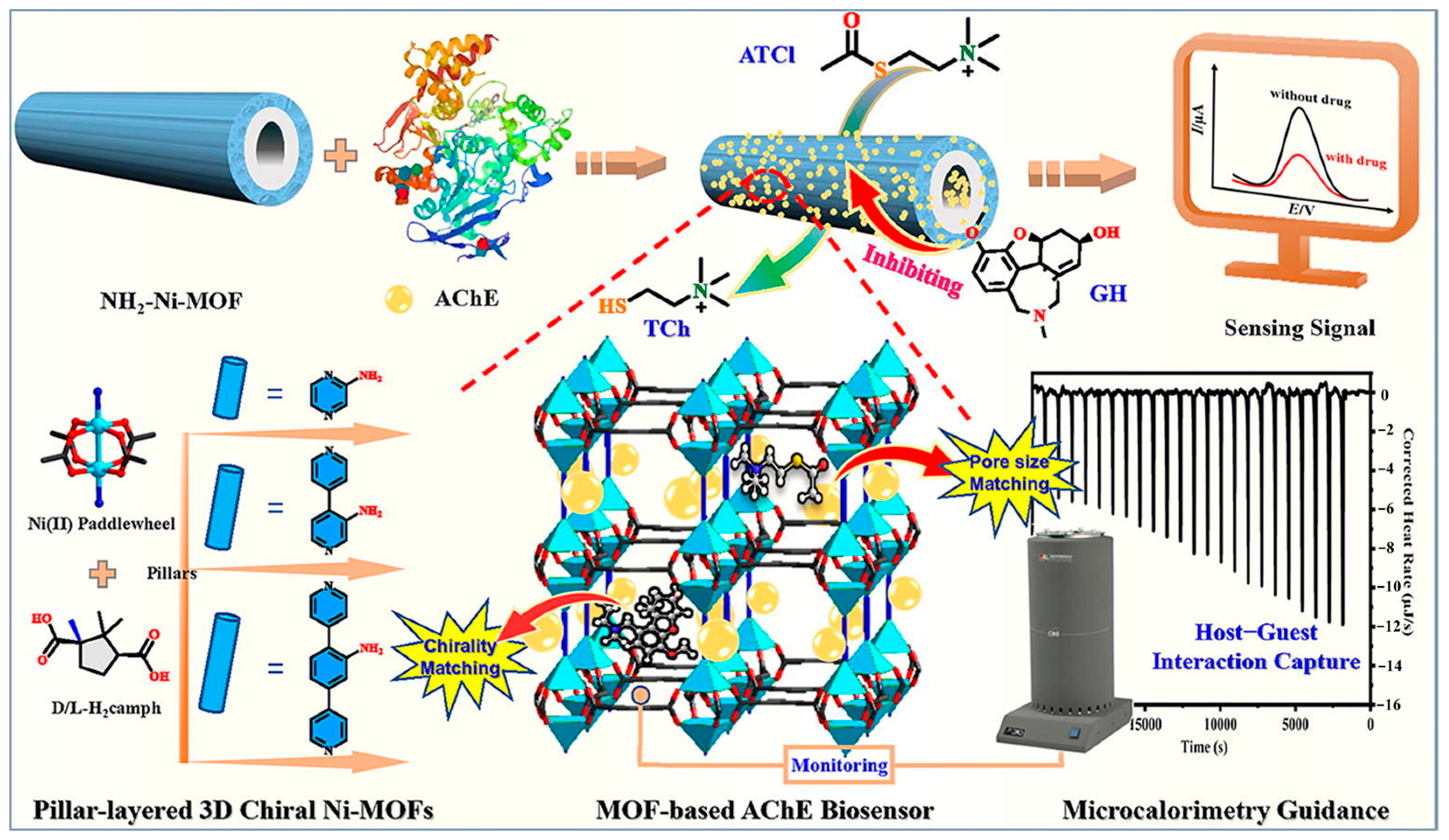
| Nanozyme | Activity | Analyte | Method | LOD (μM) | Linear Range (μM) | Selectivity Factor | Ref. |
|---|---|---|---|---|---|---|---|
| S-CuO | POD | R/S-MA | UV–Vis | – | – | – | [21] |
| D-Cys@Au/Fe Hops | POD | D-DOPA | UV–Vis | – | – | 3.70 | [40] |
| L-Cys@Au/Fe Hops | L-DOPA | – | – | 2.81 | |||
| Fe-P-GO-COOH/Fe-M-GO-COOH | POD | D/L-DOPA | UV–Vis | – | – | – | [45] |
| D-C-Dots | OXD | D/L-DOPA | UV–Vis | – | – | 2.11 | [26] |
| L-C-Dots | 1.95 | ||||||
| D/L-Mn-CDs | OXD | D/L-DOPA | UV–Vis | – | – | – | [27] |
| D-Cys@AuNPs-EMSN | POD | D/L-DOPA | UV–Vis | – | – | 1.47 | [23] |
| L-Cys@AuNPs-EMSN | 1.69 | ||||||
| CeNP@D-Phe | OXD | D/L-DOPA | UV–Vis | – | – | 1.13 | [24] |
| CeNP@L-Phe | 1.87 | ||||||
| D/L-Cys-MoS2 QDs | POD | D/L-Tyr | UV–Vis | – | – | 6.77 | [25] |
| D-FexCuySe NPs | POD | D/L-DOPA | UV–Vis | 1.02 (L) | 5–125, 125–1000 | 1.49 | [46] |
| L-FexCuySe NPs | 1.56 | ||||||
| D-His@Fe-COF | POD | D/L-DOPA | UV–Vis | – | – | 1.51 | [47] |
| L-His@Fe-COF | 1.86 | ||||||
| MOF-D-His-Cu | COs | D/L-DOPA | UV–Vis | 0.37 (L); 0.50 (D) | 0.6–300 | 2.12 | [48] |
| MOF-L-His-Cu | 0.59 (L); 0.51 (D) | 2.19 | |||||
| D/L-Pen-nanoflowers | LAC | L-EP | UV–Vis | – | – | 1.96 | [49] |
| L-DA | 1.61 | ||||||
| L-NE | 1.83 | ||||||
| L-DOPA | 2.97 | ||||||
| DNA-capped AuNPs | GOx | D/L-Glu | UV–Vis | – | – | 1.33; 1.37 | [50] |
| D/L-Phe-NP film | OXD | D/L-Glu | UV–Vis | – | – | – | [51] |
| Fe3O4@Poly(D-Trp) | POD | D/L-Tyrosinol | UV–Vis | – | – | 5.38 | [52] |
| Fe3O4@Poly(L-Trp) | 4.02 | ||||||
| DCDH@CuNPs | POD | D/L-DOPA | UV–Vis | – | – | 1.85 | [53] |
| FFCH@CuNPs | POD | D/L-DOPA | UV–Vis | 1.0 (D) | 2.0–35.0 | – | [54] |
| Ac-I3H-NH2, Ac-I3DH-NH2 | POD | D/L-DOPA | UV–Vis | – | – | – | [28] |
| AuNP@LIPIA 1 | POD | D/L-DOPA | UV–Vis | – | – | 1.90 | [29] |
| (M)-L-PhgC16-NR-M(ii) | POD | D/L-DOPA | UV–Vis | – | – | 2.35 | [30] |
| (P)-D-PhgC16-NR-M(ii) | 2.80 | ||||||
| P-PANI–Fe3O4 | POD | D/L-DOPA | UV–Vis | – | – | 1.98 | [55] |
| M-PANI–Fe3O4 | 1.88 | ||||||
| M-PANI-TA-M2+ | POD | D/L-DOPA | UV–Vis | – | – | 1.70 | [56] |
| P-PANI-TA-M2+ | 2.07 | ||||||
| CD-SQDs | hydrolase | D/L-Trp | Fluorescence | 2.3 × 10−3 (L) | 0.01–0.50 | – | [57] |
| AuNP@6-Iz-α-CD | GOx | D/L-Ribose, D/L-Lyxose, D/L-Xylose, D/L-Mannose, D/L-Glu | UV–Vis | – | – | – | [58] |
| Aptamer-Modified Cu2+-Functionalized CDs | Aptananozymes | D/L-DOPA | UV–Vis | – | – | 4.20 | [59] |
| Co2+-ZIF-67/PAN | POD | D/L-DOPA | UV–Vis | – | – | – | [60] |
| Nanozyme | Activity | Analyte | Method | LOD (μM) | Linear Range (μM) | Selectivity Factor | Ref. |
|---|---|---|---|---|---|---|---|
| OPECT | OXD | D/L-Glu | Electrochemical | 0.05 (D); 0.07 (L) | 0.1–10, 10–10,000 | – | [22] |
| GNS-PNP-β-CD-CPE | esterase | R/S-CLP | Electrochemical | 0.210 (S); 0.487 (R) | 2.0–200 | – | [95] |
| D-Cys@N-CuO/CoO NFs | POD | D/L-DOPA | Electrochemical | 3.10 × 10−4 (D); 2.90 × 10−4 (L) | 1 × 10−2–4 × 10−2 | 1.36 | [96] |
| L-Cys@N-CuO/CoO NFs | 1.71 | ||||||
| LH/RH-SNRS, LH/RH-HNRS | POD | D/L-Trp | Electrochemical | – | – | – | [97] |
| L-glutamine/MIL-125 (Ti) /TiNM | POD | D/L-DOPA | Electrochemical | 3.2 (L); 3.6 (D) | 10–200, 200–1000 | – | [98] |
| Fe3+: L-MOFs/TiNM | POD | D/L-Cystine | Electrochemical | 13.6 (L) | 25–400 | – | [99] |
| GOx/PB/CM | POD | D/L-Glu | Electrochemical | – | – | – | [100] |
| D-Ni-PYR, D-Ni-BPY, L-Ni-BPY, D-Ni-BPB | OXD | GH | Electrochemical | 8.09 × 10−6; 5.1 × 10−7; 3.1 × 10−7; 1.69 × 10−6 | 1 × 10−6–1 | – | [101] |
| Au@Meso-L-CuMOF/TiO2M | POD, OXD | D/L-mannose, D/L-xylose, D/L -tagatose, D/L-ribose, D/L-galactose, D/L-Glu | Electrochemical | 0.089 (D-Glu) | 0.1–1; 1.0–10 | – | [102] |
| MnO2/L-MIL-125/TiNM | GOx, POD | D/L-Pen | Electrochemical | 13 (D) | 50–1000 (L); 25–1000 (D) | – | [103] |
Disclaimer/Publisher’s Note: The statements, opinions and data contained in all publications are solely those of the individual author(s) and contributor(s) and not of MDPI and/or the editor(s). MDPI and/or the editor(s) disclaim responsibility for any injury to people or property resulting from any ideas, methods, instructions or products referred to in the content. |
© 2024 by the authors. Licensee MDPI, Basel, Switzerland. This article is an open access article distributed under the terms and conditions of the Creative Commons Attribution (CC BY) license (https://creativecommons.org/licenses/by/4.0/).
Share and Cite
Dai, J.-J.; Chen, G.-Y.; Xu, L.; Zhu, H.; Yang, F.-Q. Applications of Nanozymes in Chiral-Molecule Recognition through Electrochemical and Ultraviolet–Visible Analysis. Molecules 2024, 29, 3376. https://doi.org/10.3390/molecules29143376
Dai J-J, Chen G-Y, Xu L, Zhu H, Yang F-Q. Applications of Nanozymes in Chiral-Molecule Recognition through Electrochemical and Ultraviolet–Visible Analysis. Molecules. 2024; 29(14):3376. https://doi.org/10.3390/molecules29143376
Chicago/Turabian StyleDai, Jing-Jing, Guo-Ying Chen, Lei Xu, Huan Zhu, and Feng-Qing Yang. 2024. "Applications of Nanozymes in Chiral-Molecule Recognition through Electrochemical and Ultraviolet–Visible Analysis" Molecules 29, no. 14: 3376. https://doi.org/10.3390/molecules29143376





